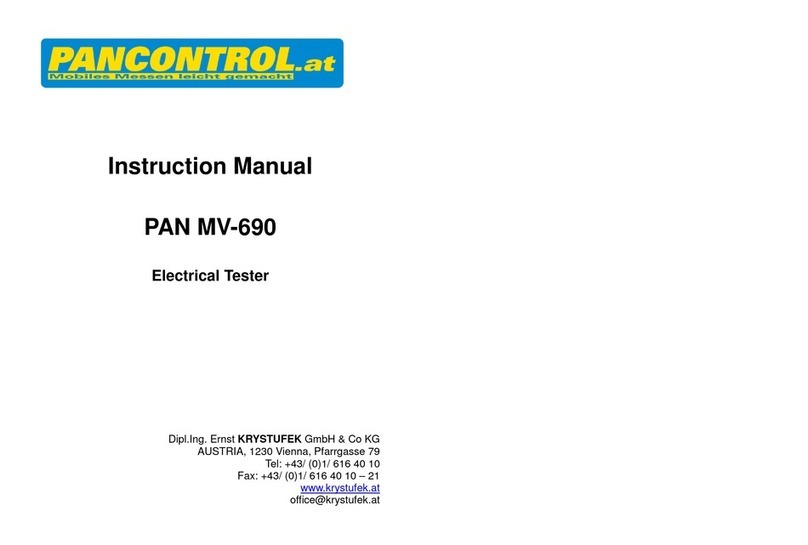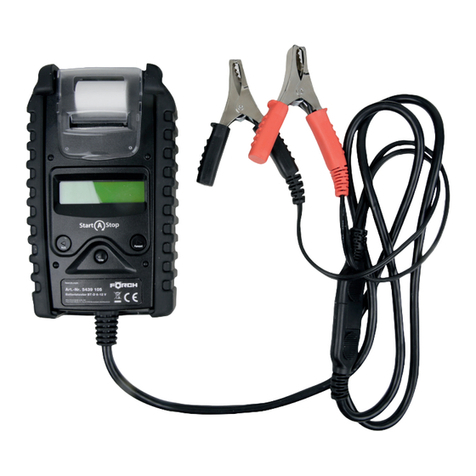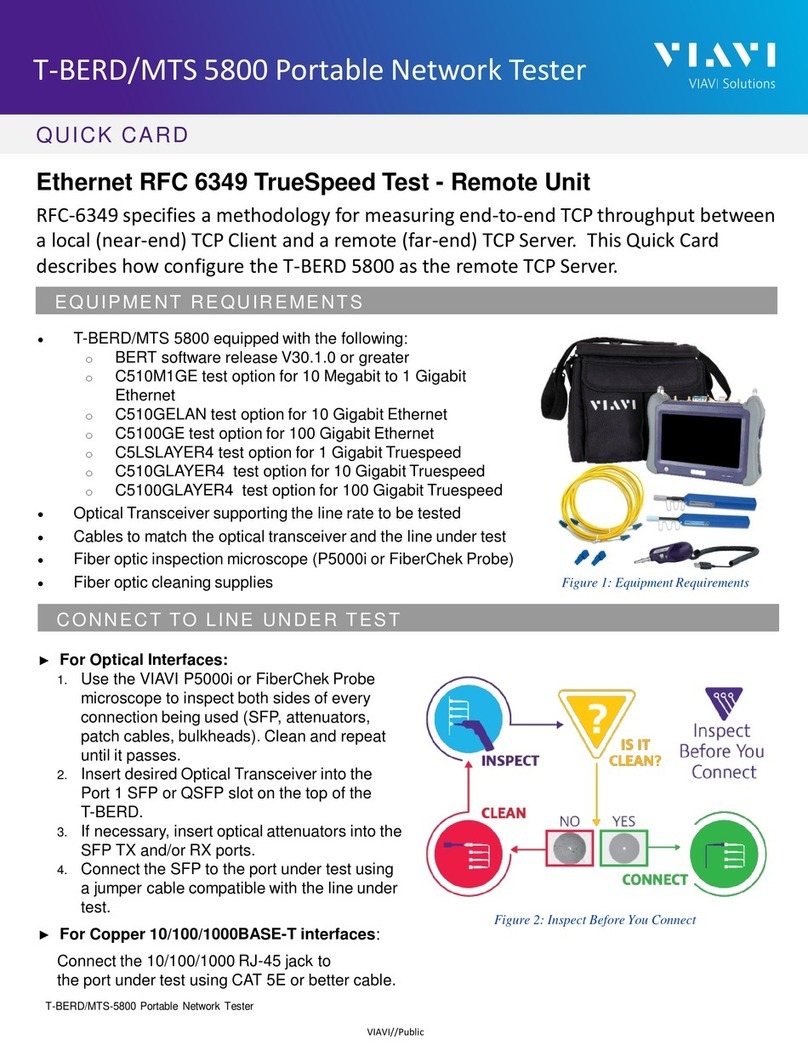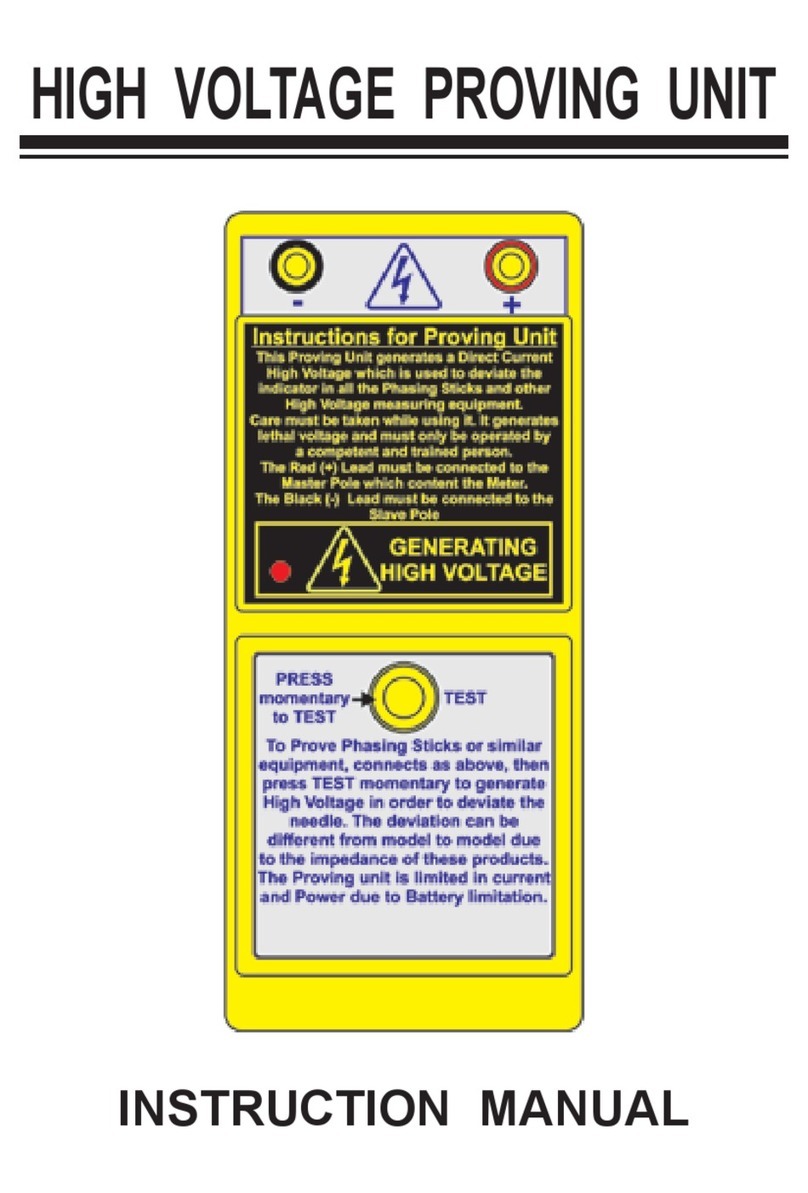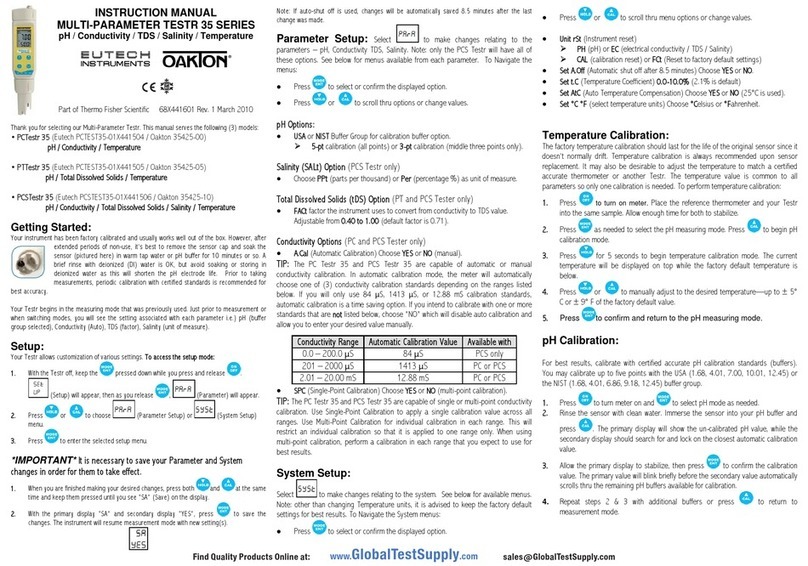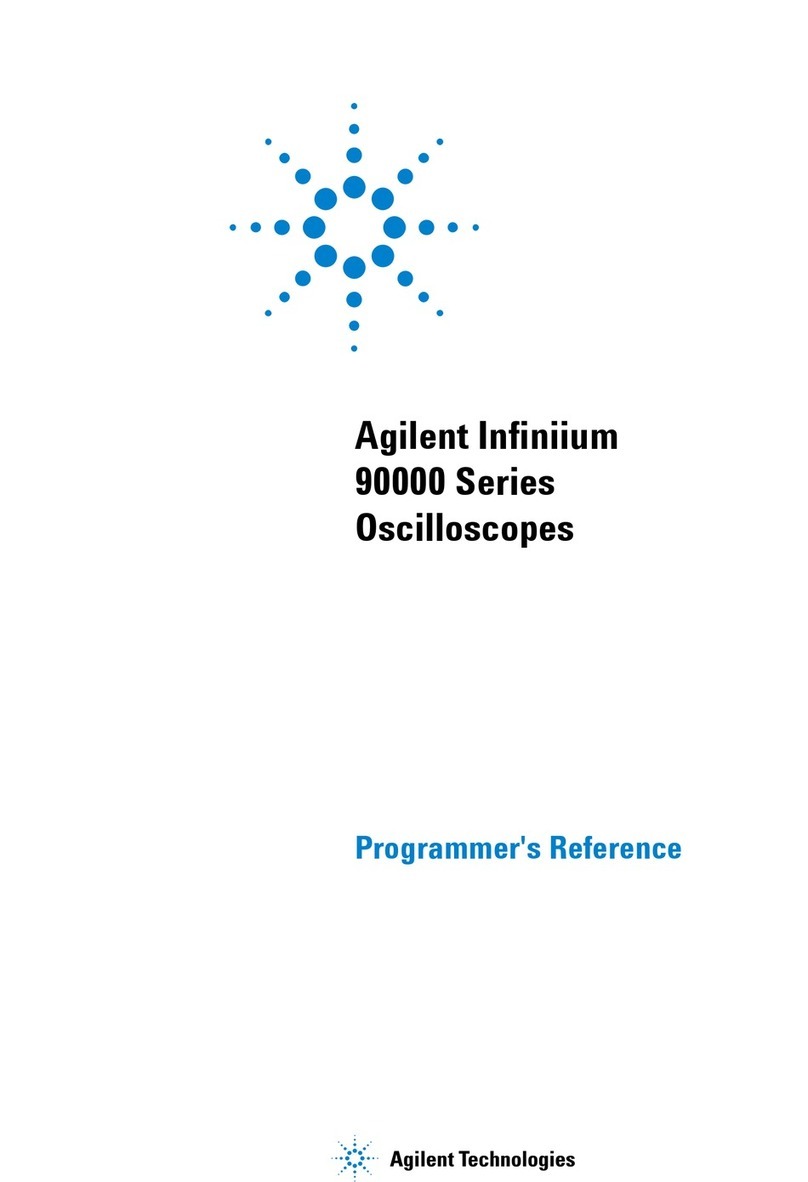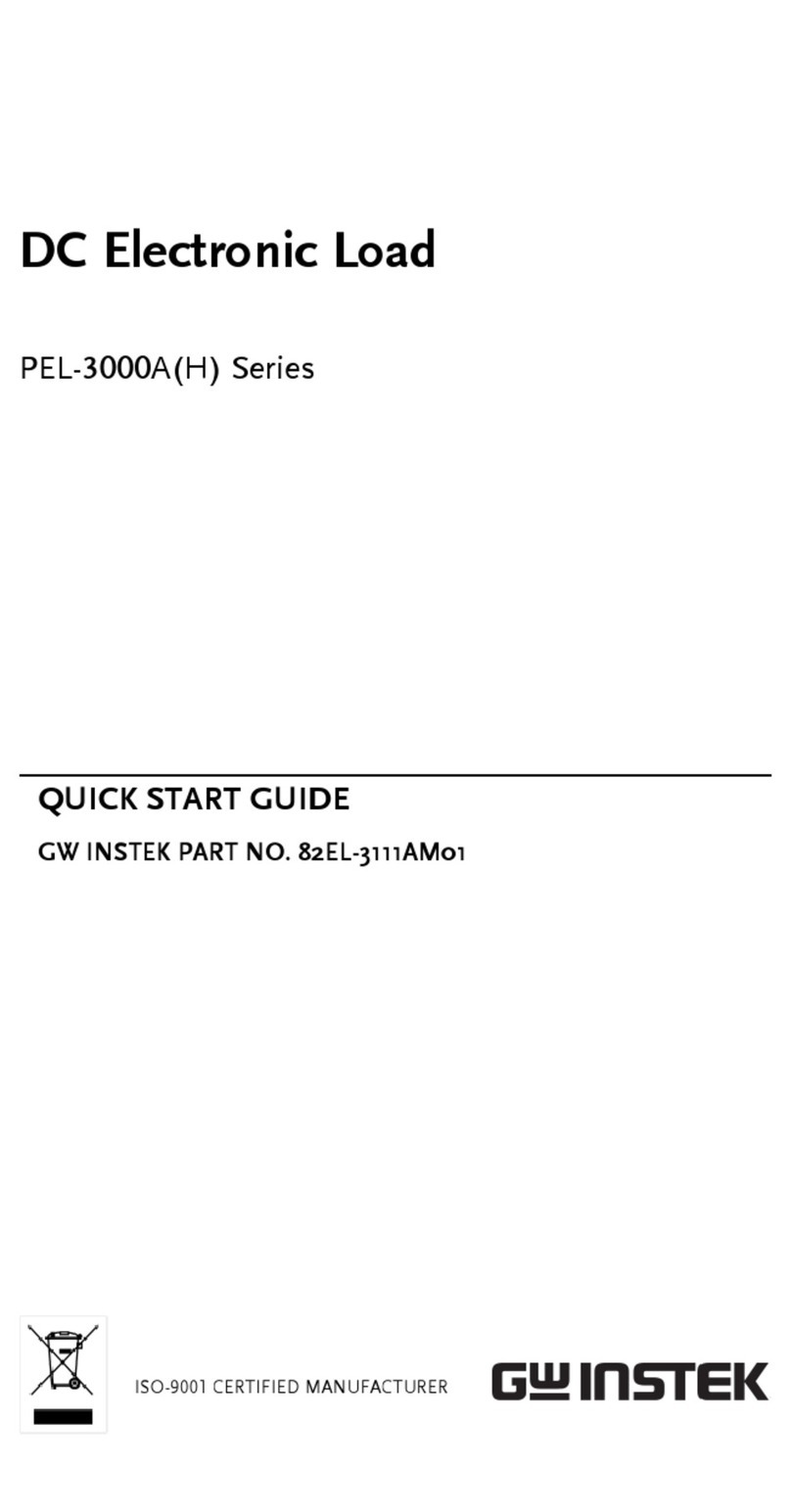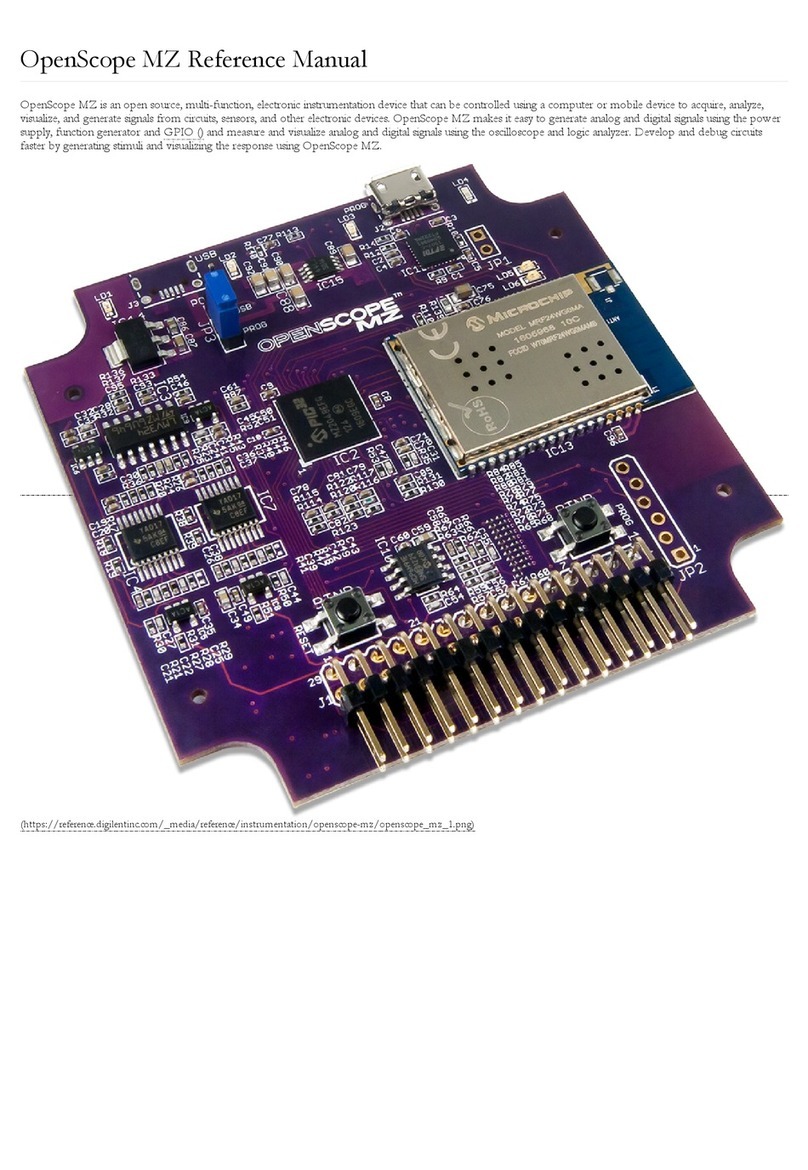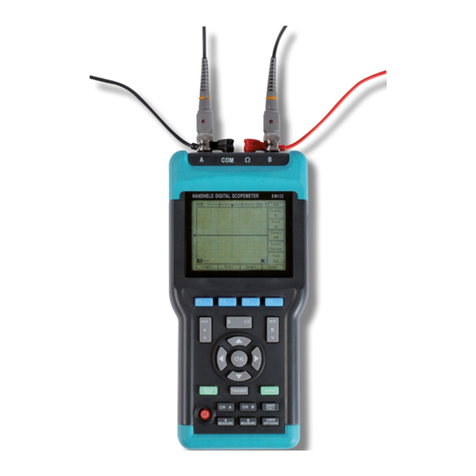Audio Precision ATS-2 User manual

Getting Started with Your ATS-2
ATS-2


Getting Started
with ATS-2
An Introductory Guide to ATS-2
APIB and GPIB Configurations

All content in this manual is owned by Audio Precision and is
protected by United States and international copyright laws.
Audio Precision allows its customers to make a limited number
of copies of this manual, or portions thereof, solely for use in
connection with the Audio Precision product covered by this
manual. Audio Precision may revoke this permission to make
copies at any time. You may not distribute any copies of the
manual, apart from a transfer of ownership of the Audio
Precision product.
Audio Precision®, System One®, System Two™, System Two
Cascade™, System One + DSP™, System Two + DSP™, Dual
Domain®, FASTTEST®, APWIN™, ATS™ and ATS-2™ are
trademarks of Audio Precision, Inc. Windows® is a trademark
of Microsoft Corporation.
Published by:
5750 SW Arctic Drive
Beaverton, Oregon 97005
1-800-231-7350
fax 503-641-8906
503-627-0832
ap.com
Printed in the United States of America
Copyright Ó 2001–2011 Audio Precision, Inc.
All rights reserved.
Audio Precision PN 8211.0136 Revision 7
XI0920164652

Contents
Safety Information...........................v
Safety Symbols ............................vi
Disclaimer ...............................vi
Chapter 1
General Information ..........................1
ATS-2: An Overview...........................1
APIB ..................................2
GPIB ..................................2
ATS-2 Capabilities............................2
Conceptual Architecture of ATS-2 ..................3
About This Manual ...........................4
Online Help ...............................4
Other Documentation for ATS-2 ...................4
ATS-2 User’s Manual .........................4
AP Basic User’s Guide and Language Reference .........5
AP Basic Extensions Reference for ATS-2 .............5
Other Publications ..........................5
GPIB Documentation for ATS-2 ...................5
Chapter 2
Installation and Setup for APIB ...................7
ATS-2 Components ...........................7
Getting Up and Running .......................7
Installing ATS Software on a PC ....................8
PC System Requirements ......................8
Installing the Software .......................9
Setting Up the ATS-2 Hardware ....................9
Connecting ATS-2 to the Electrical Mains Supply .........9
Checking the Mains Supply Voltage Configuration ......10
Opening the Power Entry Module ...............10
Changing the Mains Supply Voltage Configuration......11
Getting Started with ATS-2 i

Fuse Information ..........................12
Changing the Fusing Arrangement ..............12
Connecting ATS-2 to Your PC ....................13
The USB-APIB adapter and cables .................13
The APIB PCI Express card and cable ...............14
The APIB PCI card and cable ....................14
The APIB PCMCIA card and cable .................15
Chapter 3
Hardware Overview..........................17
ATS-2 Front Panel ...........................17
ATS-2 Rear Panel............................18
Chapter 4
ATS-2 User Interface .........................21
Overview................................21
A Note on Nomenclature ......................21
Starting up the ATS Software ....................22
ATS Workspace ............................22
ATS Panels ...............................23
Panel Settings............................24
Panel Readings ...........................24
ATS Menus ...............................25
File Menu ..............................25
Edit Menu ..............................25
View Menu..............................25
Panels Menu.............................25
Sweep Menu ............................25
Compute Menu ...........................26
Macro Menu .............................26
Utilities Menu ............................26
Window Menu ...........................26
Help Menu..............................26
Status Bar ...............................26
Toolbars and Buttons ........................27
Standard Toolbar..........................27
Panels Toolbar ...........................27
Macro Toolbar ...........................27
Learn Mode Toolbar ........................28
Quick Launch Toolbar .......................28
Using Files with ATS..........................28
Test Files...............................28
Macro Files .............................29
Data Files ..............................29
Waveform Files ...........................30
ii Getting Started with ATS-2

Log File ...............................30
Downloadable Filter Files .....................30
Chapter 5
Quick Guides ..............................31
Introduction .............................31
Quick Guide to the Analog Signal Path ...............31
Analog Input Panel .........................31
Analog Generator Panel ......................31
Analyzer Panel ...........................32
Signal Monitor ...........................33
Controlling the Analog Generator ................33
Units .................................34
Quick Guide to Sweeps ........................35
Sweep Fundamentals .......................36
Settings and Readings ......................36
Source Range, Steps, and Spacing ...............37
Data Display Range ........................37
Example Sweep: Frequency Response ..............38
Review...............................38
Example Sweep: Amplitude Linearity ..............39
Quick Guide to the FFT Spectrum Analyzer ............40
Real-Time vs. Batch-Mode Instruments..............40
The FFT Concept ..........................41
Setting up an FFT ..........................41
Panel Fields ............................42
Time vs. Frequency .......................42
Quick Sweep Setup........................42
Fine-Tuning the Display .....................43
Saving and Loading Tests ......................44
The Next Step .............................44
Chapter 6
Specifications .............................45
Chapter 7
GPIB Configuration ..........................59
Introduction .............................59
APIB or GPIB? ............................59
The GPIB Software Development Process .............60
Using both GPIB and APIB for Software Development .....62
Establishing GPIB Communication ................63
GPIB Connection .........................63
ATS-2 GPIB Address and I/O Mode Switch ...........65
GPIB Status LEDs .........................67
Getting Started with ATS-2 iii

Safety Information
Do NOT service or repair this product unless properly qualified. Servic-
ing should be performed only by a qualified technician or an authorized
Audio Precision distributor.
Do NOT defeat the safety ground connection. This product is designed
to operate only from a 50/60 Hz AC power source (250 V rms maximum)
with an approved three-conductor power cord and safety grounding. Loss
of the protective grounding connection can result in electrical shock hazard
from the accessible conductive surfaces of this product.
For continued fire hazard protection, fuses should be replaced ONLY
with the exact value and type indicated on the rear panel of the instrument
and discussed on page of this manual. The AC voltage selector also must
be set to the same voltage as the nominal power source voltage (100, 120,
230, or 240 V rms) with the appropriate fuses. Different fuses are required
depending on the line voltage.
The International Electrotechnical Commission (IEC 1010-1) requires
that measuring circuit terminals used for voltage or current measurement
be marked to indicate their Installation Category. The Installation Category
is defined by IEC 664 and is based on the amplitude of transient or im-
pulse voltage that can be expected from the AC power distribution net-
work. This product is classified as INSTALLATION CATEGORY I,
abbreviated “CAT I” on the instrument front panel.
Do NOT substitute parts or make any modifications without the written
approval of Audio Precision. Doing so may create safety hazards.
This product is for indoor use—pollution degree 2.
Getting Started with ATS-2 v

Safety Symbols
The following symbols may be marked on the panels or covers of equip-
ment or modules, and are used in this manual:
WARNING!—This symbol alerts you to a potentially hazardous condi-
tion, such as the presence of dangerous voltage that could pose a risk of
electrical shock. Refer to the accompanying warning label or tag, and exer-
cise extreme caution.
ATTENTION!—This symbol alerts you to important operating consider-
ations or a potential operating condition that could damage equipment. If
you see this marked on equipment, refer to the Operator’s Manual or
User’s Manual for precautionary instructions.
FUNCTIONAL EARTH TERMINAL—A terminal marked with this sym-
bol is electrically connected to a reference point of a measuring circuit or
output and is intended to be earthed for any functional purpose other than
safety.
PROTECTIVE EARTH TERMINAL—A terminal marked with this sym-
bol is bonded to conductive parts of the instrument and is intended to be
connected to an external protective earthing system.
Disclaimer
Audio Precision cautions against using their products in a manner not
specified by the manufacturer. To do otherwise may void any warranties,
damage equipment, or pose a safety risk to personnel.
vi Getting Started with ATS-2

Chapter 1
General Information
ATS-2: An Overview
The Audio Precision ATS-2 is a powerful computer-controlled audio test
and measurement system consisting of two key components:
§The ATS-2 hardware: the connectors and circuitry necessary for
precise signal generation and analysis, and for interfacing to devices.
The hardware is mounted in a compact (2 U) aluminum and steel
chassis that can be installed in a standard equipment rack using
optional mounting hardware.
§The ATS measurement software, which runs on a personal computer
(PC), and provides the control, display, report and automation
functions for the ATS-2 system. The ATS software will run under
Microsoft Windows XP, Windows Vista and Windows 7.
With the exception of the mains power switch on the rear panel, there
are no knobs, dials, controls, readouts, meters or switches on the ATS-2
chassis. All of these functions are performed via the ATS software on the
controlling PC.
Getting Started with ATS-2 1
Figure 1. The Audio Precision ATS-2 audio test and measurement system.

APIB
The ATS control software on the PC communicates with the ATS-2
hardware in one of two ways:
§USB-APIB
Introduced with the release of ATS version 1.6, the USB-APIB
adapter provides a convenient USB interface to the instrument. USB
operation is not supported by earlier versions of ATS.
§APIB
APIB (Audio Precision Interface Bus) is a proprietary bus
interconnection that requires a dedicated APIB cable and
PC-mounted APIB interface card or adapter. APIB interfaces are
available as PCI, PCI Express or PCMCIA-compatible devices.
The USB-APIB adapter or APIB interface are specified at the time your
system is ordered. An interface adapter kit can also be ordered separately.
GPIB
When ordered in the optional GPIB configuration (ATS2G), ATS-2 can
also be controlled by the industry-standard IEEE 488.2 General Purpose
Interface Bus (GPIB). See Chapter 7for more information about the
ATS-2 GPIB configuration.
ATS-2 Capabilities
§ATS-2 can make amplitude, frequency, THD+N, noise, phase,
crosstalk, bandpass, and IMD measurements for analog or digital
audio devices. In a special function, ATS-2 can perform detailed
analysis and measurement of harmonic distortion products.
§ATS-2 can perform complex sweeps, and display and print the results
with a powerful graphing engine. ATS-2 offers control over
instrument regulation and settling parameters. Data obtained from
sweeps can be compared to pre-defined limits. A variety of
computations can be performed on the measured data after
acquisition. Tests and data can be saved and recalled, and ATS-2
measurements can be automated by macros written in the AP Basic
programming language.
§ATS-2 can perform measurements using fast Fourier transform (FFT)
analysis. Advanced high-speed FFT analysis techniques are available,
including multitone recognition and analysis, frequency adjustment
for bin centering, synchronous FFT processing, and advanced
post-FFT analysis.
Chapter 1: General Information ATS-2 Capabilities
2Getting Started with ATS-2

§ATS-2 can examine an AES/EBU digital interface signal and assure
the integrity of digitally transmitted data. It can also measure and
examine the jitter in the waveform. ATS-2 can extract a variety of
statistics from a digital waveform, including the sample rate, the
interface waveform voltage, the jitter amplitude, and the active and
inactive data bits. ATS-2 also has the capability of transmitting and
receiving a full complement of AES/EBU status bits.
§ATS-2’s sample rate may be synchronized to an external AES/EBU
signal, a square wave, or an NTSC or PAL video source.
§ATS-2 has two auxiliary control connectors for control of external
equipment.
Conceptual Architecture of ATS-2
The functional components implemented in ATS-2 include two audio
signal generators, an audio signal analyzer, digital and analog input and
output modules, and a module for external timebase synchronization.
All signal generation is performed in the digital domain. One of the two
signal generators is dedicated to the digital output. The signal from this
digital generator is buffered and conditioned for the balanced, unbalanced
and optical outputs. The output of the second signal generator is con-
verted to an analog signal by a digital-to-analog converter (DAC). The
two-channel output of the DAC is conditioned and ranged for the
balanced and unbalanced analog outputs.
All signal analysis is also performed in the digital domain. The digital in-
put is buffered and directly applied to the analyzer. Analog inputs are first
ranged and conditioned, and then digitized by a high-resolution ana-
log-to-digital converter (ADC) before being applied to the analyzer. An op-
tional high-bandwidth ADC is available to increase measurement
bandwidth.
Conceptual Architecture of ATS-2 Chapter 1: General Information
Getting Started with ATS-2 3
Analog Domain vs. Digital Domain
Analog audio signals are electrical analogies of the sound waves
that they represent, varying in frequency and amplitude in a continuous
fashion. In analog audio electronics, these voltages and currents are
manipulated, processed, and measured by modifying their amplitude or
frequency. The term analog domain refers to signals represented and
processed in this fashion.
Digital audio signals, on the other hand, are numerical
representations of the sound waves. The representation is often carried
on an electrical signal called the interface signal. Digital audio is
processed mathematically in processes gathered together under the
name of Digital Signal Processing, or DSP. The term digital domain
refers to signals represented and processed in this fashion.

About This Manual
You’re reading Getting Started with ATS-2. This manual describes how
to set up the ATS-2 hardware and ATS software. It also contains a quick
tutorial to familiarize you with the system. It is organized as follows:
§Chapter 2: Software installation and hardware setup information.
§Chapter 3: Description of the hardware and its connectors.
§Chapter 4: Description of the user interface.
§Chapter 5: Introductory tutorial.
§Chapter 6: Specifications.
§Chapter 7: GPIB Configuration.
Online Help
Much of the information contained in the ATS-2 User’s Manual is also
available in the online help system included in the ATS software. You can
access the help system in two ways:
§ATS has context-sensitive help. Almost every control and display on
each software panel has a help topic associated with it. To view the
topic, click on the field or control, then press the F1 function key.
§On the Menu bar, click Help. The Help menu offers commands to
search the Help Index, browse through the Help Topics, or select
a specific help library such as AP Basic Language.
Other Documentation for ATS-2
Audio Precision publishes a variety of documents, many in electronic
form, about hardware and software products, audio theory, and test and
measurement techniques. The following list describes the documents that
are included as Adobe Acrobat Portable Document Format (PDF) files on
the Audio Precision Resources Disc. They can also be downloaded from
our Web site at ap.com.
ATS-2 User’s Manual
The ATS-2 User’s Manual is the primary operation and reference man-
ual for the system. Consult the ATS-2 User’s Manual for:
§Detailed descriptions of every ATS-2 feature, software panel, control,
and display.
§Reference information on audio test and measurement techniques,
sample and utility file listings, and an audio glossary.
Chapter 1: General Information About This Manual
4Getting Started with ATS-2

AP Basic User’s Guide and Language Reference
You can create tests and macros to automate your measurements. Mac-
ros are written in the AP Basic programming language, which is a subset of
Microsoft® Visual Basic®. The AP Basic User’s Guide and Language Ref-
erence, available as a PDF on the Audio Precision Resources disc, contains
a list of the AP Basic commands, each with a full description and examples
of usage.
AP Basic Extensions Reference for ATS-2
The AP Basic Extensions Reference for ATS-2, available as a PDF on
the Audio Precision Resources disc, contains a list of OLE/ActiveX automa-
tion commands that control the specific features of the ATS-2 hardware
and the ATS software.
Other Publications
Audio Precision publishes application notes, tech notes, technical papers
and training materials that cover all aspects of audio test and measure-
ment. Information about our library of technical papers and announce-
ments of new papers is available from Audio Precision Technical Support,
and on the Audio Precision Web site.
GPIB Documentation for ATS-2
When ordered in the optional GPIB configuration, ATS-2 can also be
controlled by the industry-standard General Purpose Interface Bus (GPIB).
Basic installation with GPIB is covered in Chapter 7of this manual. For
GPIB development and programming, order the ATS-2 GPIB Program-
mer’s Reference Manual, which includes a CD-ROM with GPIB sample
program files.
Other Documentation for ATS-2 Chapter 1: General Information
Getting Started with ATS-2 5

Chapter 1: General Information Other Documentation for ATS-2
6Getting Started with ATS-2

Chapter 2
Installation and Setup for APIB
ATS-2 Components
The following items are included with a standard, APIB-configured
ATS-2. For a GPIB-configured ATS-2, refer to Chapter 7.
§The ATS-2 hardware chassis.
§A mains power cord.
§A box containing the ATS-2 WIN-KIT interface kit.
The following items are contained within the ATS-2 WIN-KIT:
§This manual, Getting Started with ATS-2.
§The ATS-2 User’s Manual.
§An Audio Precision Interface Bus (APIB) USB adapter or interface
card, as ordered.
§The ATS control software CD-ROM, containing ATS control software
for the ATS-2.
§An Audio Precision Resources Disc CD-ROM, containing sample files,
user documents and other resources.
§A playable audio compact disc AP-CD0, containing audio test
signals.
We recommend that you retain the shipping box and packing materials
to protect your instrument if you need to ship it in the future.
Getting Up and Running
There are three main tasks to setting up ATS-2:
§Installing the ATS software on a personal computer (PC);
Getting Started with ATS-2 7

§Configuring ATS-2 for the local mains power supply; and
§Connecting the interface, using either the USB-APIB adapter or by
installing an APIB card in the PC.
These tasks are described below.
Installing ATS Software on a PC
PC System Requirements
Your ATS-2 instrument must be connected to a Windows-capable PC to
operate. The current control software is ATS version 1.60, SP1 (Service
Pack 1). SP1 has added 64-bit compatibility to ATS.
The PC must have the following operating system (OS), features and ca-
pabilities:
§for operation using a 64-bit OS:
Windows 7 Professional SP1 64-bit.
Windows 7 Ultimate SP1 64-bit.
§for operation using a 32-bit OS:
Windows 7 Professional SP1 32-bit.
Windows 7 Ultimate SP1 32-bit.
Windows Vista Business SP2 32-bit.
Windows Vista Ultimate SP2 32-bit.
Windows XP Professional SP3 32-bit.
NOTE: You must have local administrator rights to install ATS
software. Go to User Accounts in the Windows Control Panel,
or check with your network administrator.
§You must have at least the minimum processor type and memory
required by Microsoft for the installed operating system.
§You must have at least 300 MB of free hard disk space.
§You must have CD-ROM drive.
§for operation using a 64-bit OS:
You must have a USB 2.0 port, and use the Audio Precision
USB-APIB adapter.
§for operation using a 32-bit OS:
You must have a USB 2.0 port for a USB-APIB adapter, or an open
PCI, PCI Express or PCMCIA slot to mount the APIB interface.
§You must have a color monitor and a video card with at least VGA
capabilities. Video resolution of 1024 ´ 768 or greater is
recommended.
Chapter 2: Installation and Setup for APIB Installing ATS Software on a PC
8Getting Started with ATS-2

You will also need signal interface cables to connect your ATS-2 instru-
ment to your device under test (DUT). Since there are many possible con-
nection configurations, signal cables are not provided with the instrument.
Audio Precision offers cable kits with common connectors and adapters for
purchase. Contact a sales representative or visit the Audio Precision Web
site at ap.com for more information.
Installing the Software
To install the ATS software, use the following procedure:
§Close all Windows programs.
§Insert the ATS CD-ROM into the CD-ROM drive. The installation
program should start automatically. If it does not, click on the Start
menu and choose Run. Click Browse and choose the file Setup.exe
on the ATS CD-ROM. Click OK in the Run dialog box.
§Follow the installer on-screen instructions.
Setting Up the ATS-2 Hardware
Connecting ATS-2 to the Electrical Mains Supply
ATS-2 must be connected to a 50–60 Hz alternating current (AC) elec-
trical mains supply, maximum voltage 250 Vrms.
The units are configured at the factory for the expected voltage at their
intended destination. The voltage setting and fusing arrangement will nor-
mally be correct unless the unit has been transported into another area.
Setting Up the ATS-2 Hardware Chapter 2: Installation and Setup for APIB
Getting Started with ATS-2 9
Figure 2. Detail, power entry module on ATS-2 rear panel.

The power entry module has a strip of indicator tape showing its mains
voltage setting. This tape must be removed before use.
You MUST be sure that the ATS-2 mains power configuration
is correct for the electrical mains power supplied in your area.
If you are not sure, do not plug ATS-2 in to the mains power.
Follow the instructions below to check or change the ATS-2
mains supply voltage selection.
The mains power supply is applied to ATS-2 through the power entry
module located on the rear panel. Before connecting the power cord, con-
firm that the input voltage selection and fusing arrangement in the power
entry module are correct for your mains power supply.
Checking the Mains Supply Voltage Configuration
The voltage indicator pin protrudes through one of the four labeled
holes in the module cover to indicate the selected input voltage, as shown
in Figure 2. Check that the indicated voltage matches your mains supply
voltage.
Opening the Power Entry Module
Unplug the power cord from the instrument before changing fuses or
performing any other operations described in this section.
To open the Power Entry Module, refer to Figure 3and proceed as fol-
lows:
Chapter 2: Installation and Setup for APIB Setting Up the ATS-2 Hardware
10 Getting Started with ATS-2
Figure 3. Power entry module door and fuse block.
Other manuals for ATS-2
1
Table of contents
Other Audio Precision Test Equipment manuals
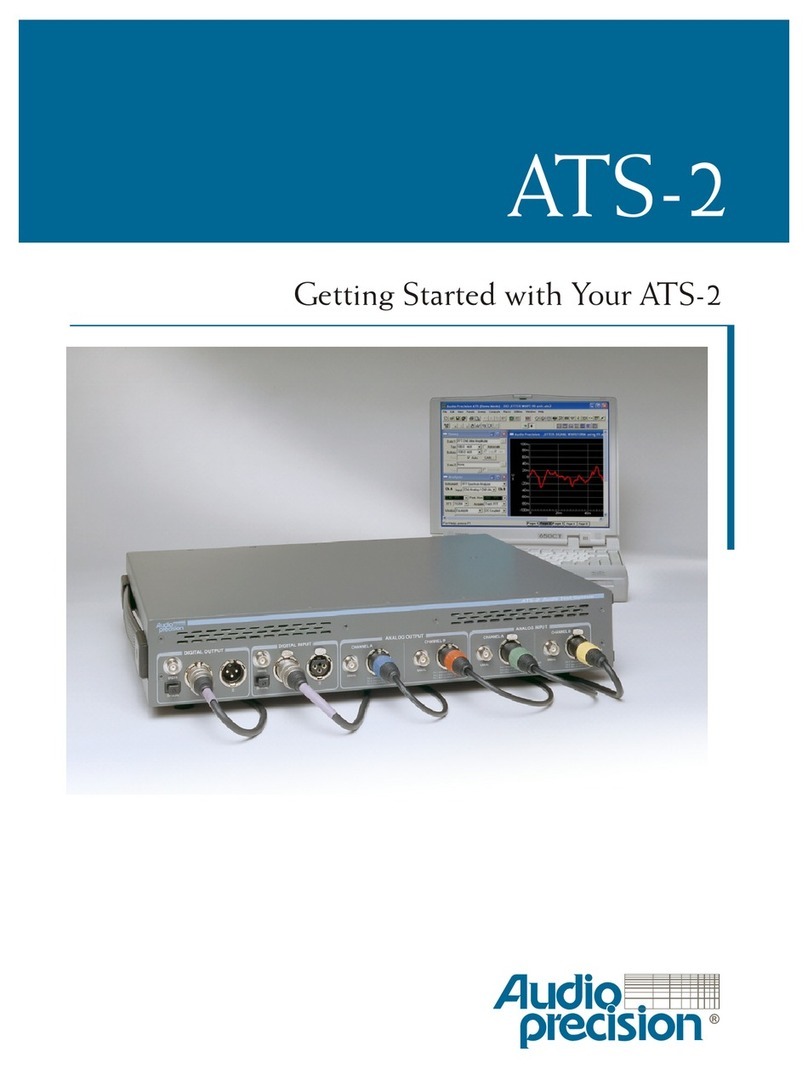
Audio Precision
Audio Precision ATS-2 User manual
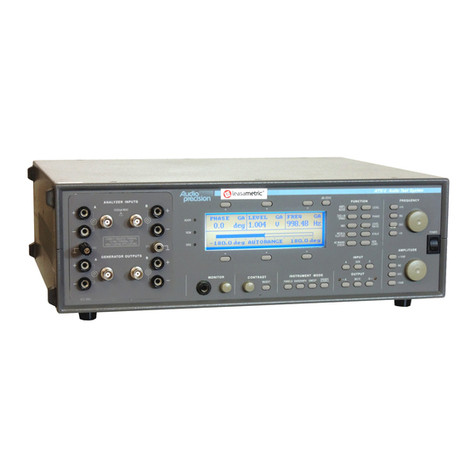
Audio Precision
Audio Precision ATS-1 User manual
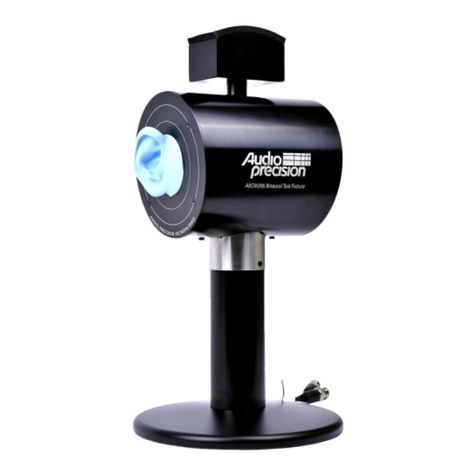
Audio Precision
Audio Precision AECM206 User manual
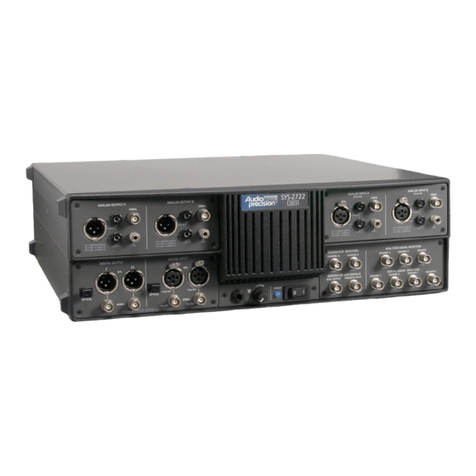
Audio Precision
Audio Precision 2700 Series User manual
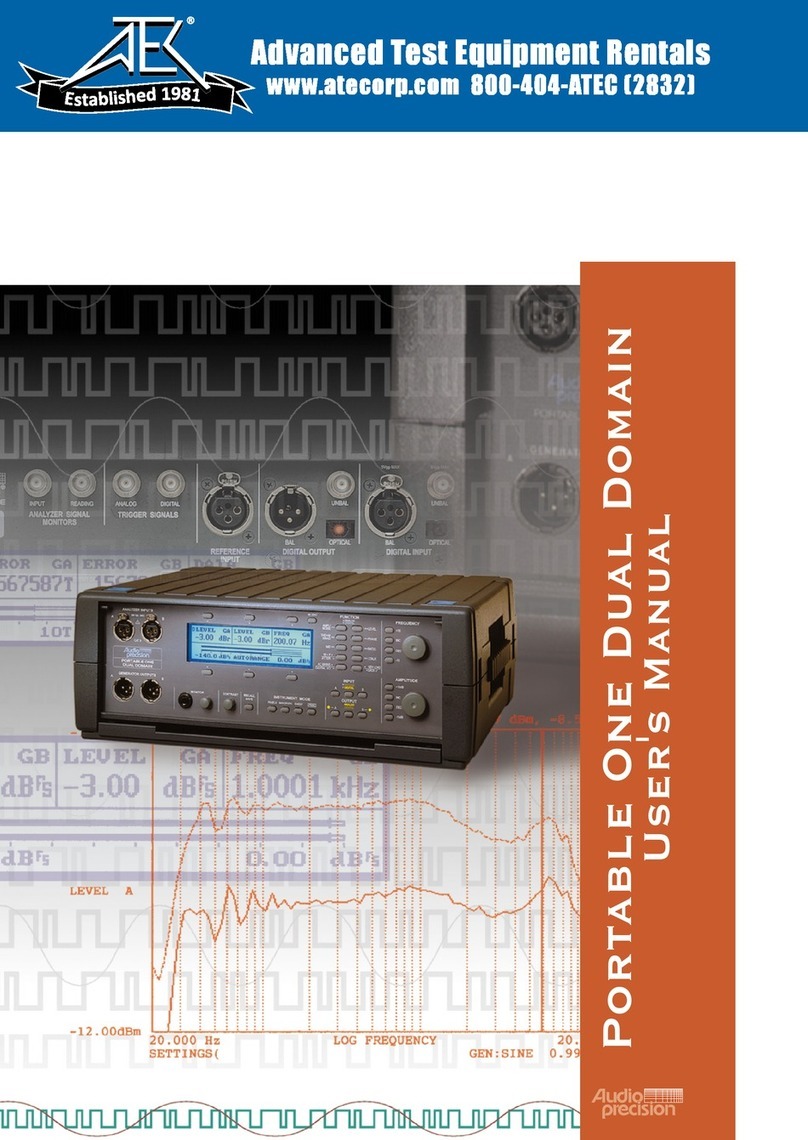
Audio Precision
Audio Precision Portable One Dual Domain User manual
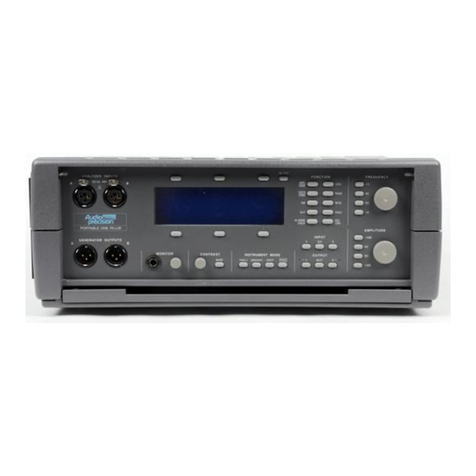
Audio Precision
Audio Precision Portable One Plus Access User manual
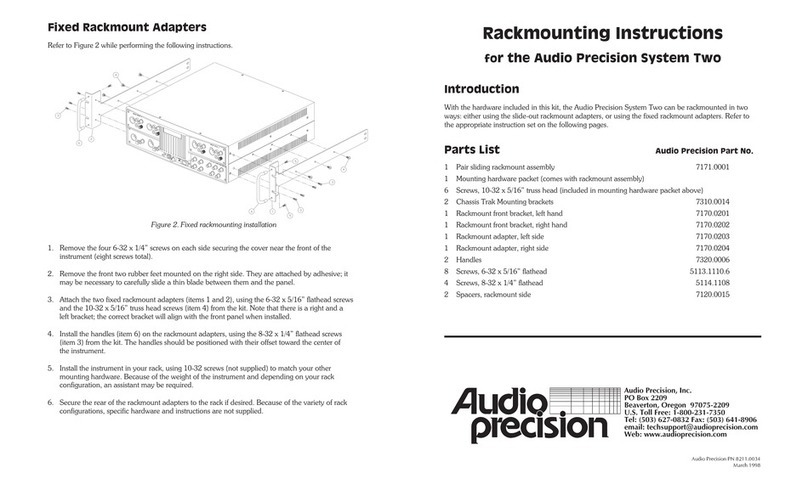
Audio Precision
Audio Precision System Two User manual

